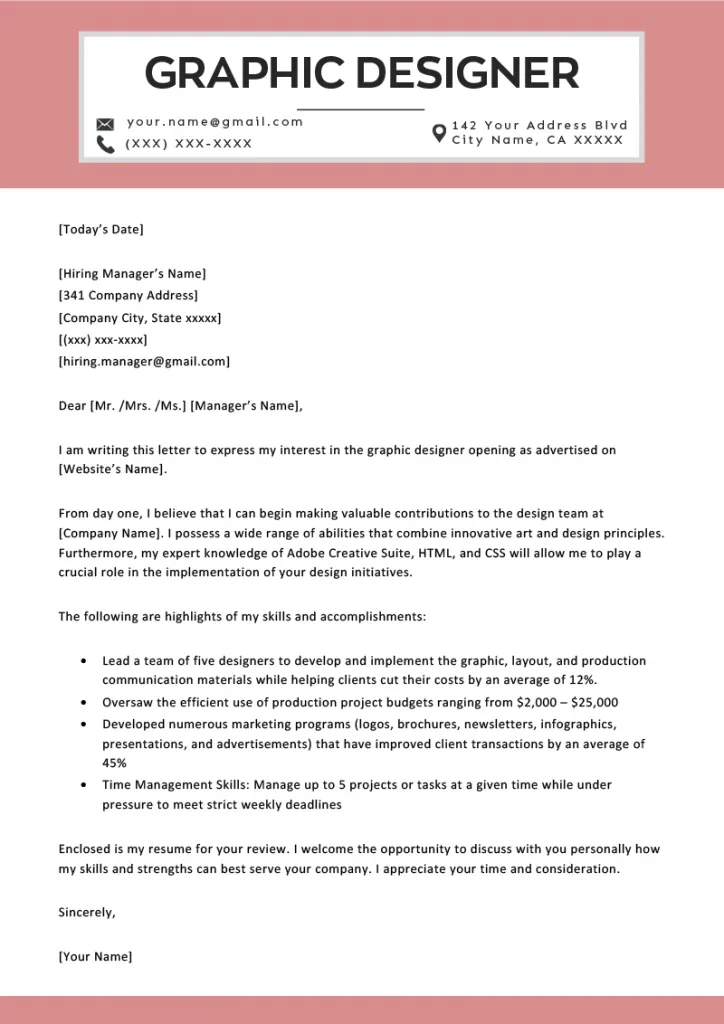7 Tips for Graphic Designer Cover Letters
A well-crafted cover letter is your first chance to impress a potential employer. For graphic designers, it’s especially crucial. Your cover letter is not just a formality; it’s an extension of your portfolio, showcasing your design sensibilities and personality. This guide provides seven essential tips to help you create a cover letter that stands out and lands you that dream job. By following these guidelines, you’ll be well on your way to making a strong first impression and securing interviews. Remember, every detail matters when you’re vying for a creative role, and your cover letter should reflect your meticulous approach to design.
Highlight Your Skills and Experience
Begin by concisely summarizing your relevant skills and experience. Graphic design is a diverse field, so tailor your skills section to align with the specific job description. Mention software proficiency (Adobe Creative Suite, etc.), specific design areas (web design, branding, etc.), and any notable achievements or projects. Quantify your accomplishments whenever possible (e.g., ‘Increased website traffic by 20%’). This helps employers quickly grasp your capabilities and see how you can contribute to their team. Don’t just list your skills; provide context that shows how you’ve used them to achieve results. Make sure your skills and experience align with the job requirements.
Showcase Your Design Portfolio
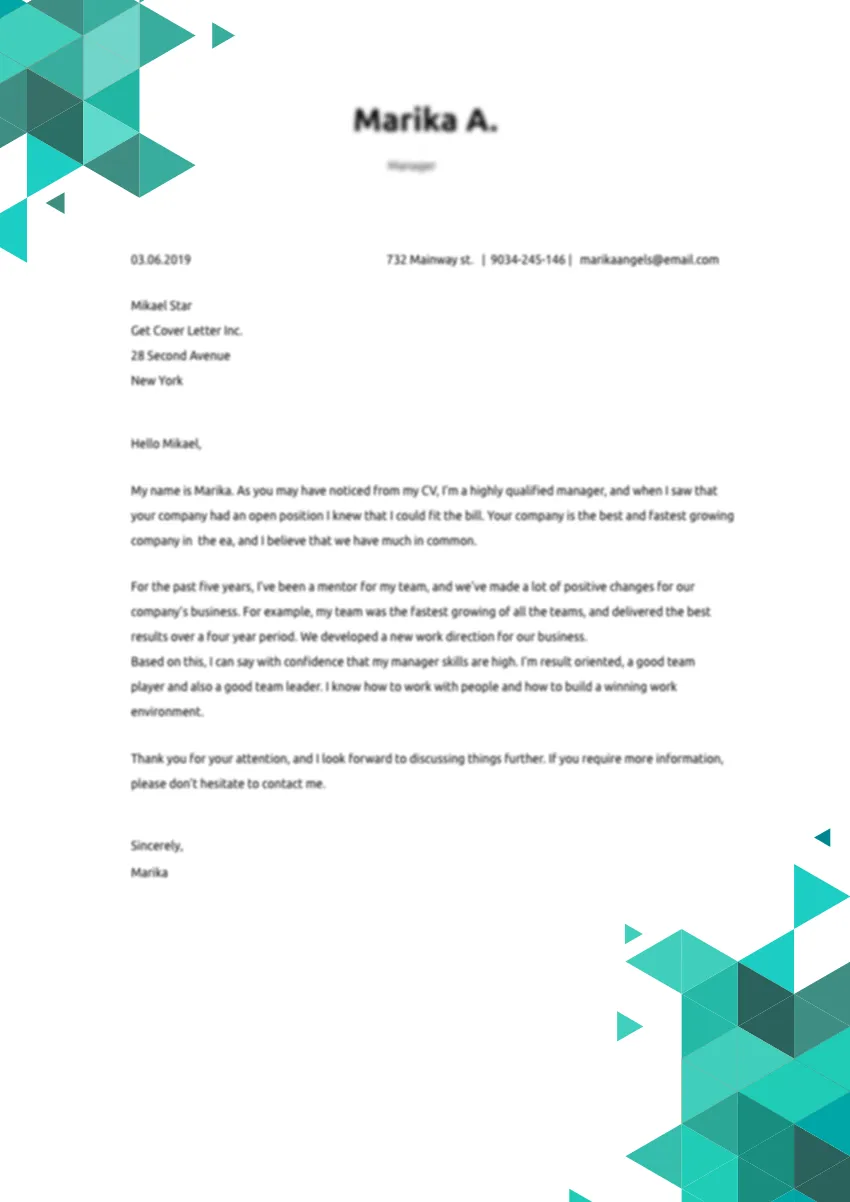
Your portfolio is your most potent tool as a graphic designer. Your cover letter should prominently feature a link to your online portfolio. Ensure your portfolio is current, well-organized, and showcases your best work. If the job description emphasizes a specific type of design, direct the hiring manager to those relevant projects. Consider including a brief description of your portfolio’s highlights in your cover letter, emphasizing the projects that best align with the company’s needs. Also, ensure that your portfolio is easily accessible and mobile-friendly, as many hiring managers will be viewing it on their phones or tablets. A great portfolio is a game-changer; make sure it shines.
Tailor Your Cover Letter
One-size-fits-all cover letters rarely impress. Customize each letter to the specific job and company. Research the company’s values, recent projects, and design style. Then, tailor your letter to demonstrate how your skills and experience align with their needs. Mention specific projects or aspects of their work that resonate with you. This shows that you’ve invested time and effort, and that you genuinely want the job. This level of personalization distinguishes you from candidates who send out generic applications, proving that you are invested in the opportunity and possess a genuine interest in the company.
Emphasize Your Understanding of the Role
Show the hiring manager that you comprehend the role’s responsibilities. Read the job description carefully, noting the required skills and expectations. In your cover letter, address these points directly. Explain how your past experiences have prepared you for the position. Discuss how you plan to approach the challenges mentioned in the job posting. This demonstrates your ability to align your skills with the company’s needs and your proactive approach to understanding the work ahead. This demonstrates foresight and proactive thinking, which employers value.
Use Keywords Strategically

Many companies use Applicant Tracking Systems (ATS) to screen applications. Incorporate keywords from the job description into your cover letter to ensure it’s noticed. But avoid keyword stuffing; ensure the language flows naturally and reflects your personality. Sprinkle these keywords throughout your letter, especially in your skills section and when describing your past projects. Doing so helps your application pass through the ATS and reach human eyes. However, ensure that the keywords integrate smoothly into the text, as an unnatural flow can be a turn-off.
Demonstrate Enthusiasm and Personality
Let your personality shine through. Graphic design is a creative field, and employers want to see your passion and enthusiasm. Inject your cover letter with your unique voice and style. Show genuine excitement for the opportunity and the company. While maintaining professionalism, don’t be afraid to add a personal touch. This could include mentioning why you admire their work or how their values align with your own. A genuine demonstration of enthusiasm will help you connect with the hiring manager and leave a memorable impression, making you more than just a resume.
Proofread Carefully
Errors in a cover letter can be a deal-breaker. Before submitting, carefully proofread your letter for any typos, grammatical errors, or formatting issues. Use a spell checker and, ideally, have someone else review it. Errors suggest a lack of attention to detail, which is a critical quality for a graphic designer. Ensure your contact information is correct and that the letter is formatted neatly and professionally. A well-proofread cover letter demonstrates your commitment to excellence and attention to detail, making you a more compelling candidate and increasing your chances of success.
Structuring Your Graphic Designer Cover Letter
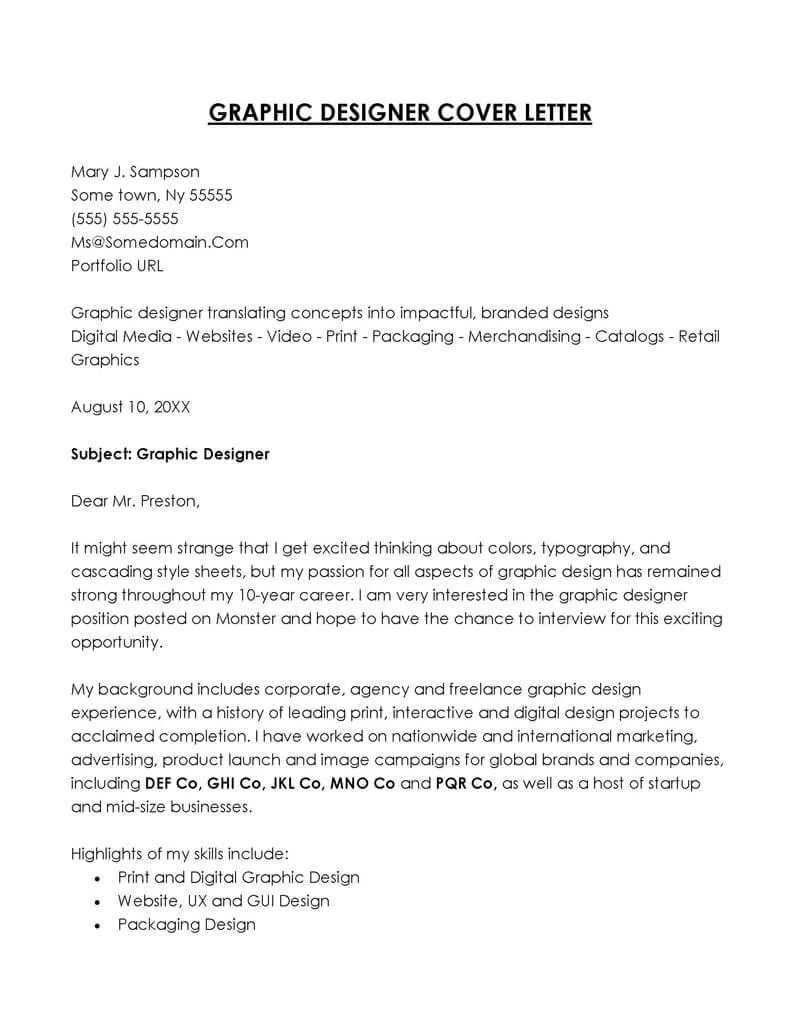
Header and Contact Information
Start with your full name, contact information (phone number, email address, and LinkedIn profile URL), and the date. Include the hiring manager’s name (if you know it) and the company’s address. Ensure all information is accurate and up-to-date. A professional header sets the tone for the entire letter and allows the hiring manager to contact you easily.
Greeting the Hiring Manager
Address the hiring manager by name. If you can’t find their name, use a general greeting like ‘Dear Hiring Manager’. Avoid generic greetings that may make your letter appear mass-produced. Personalizing the greeting shows you’ve done your research and care about the opportunity.
Opening Paragraph
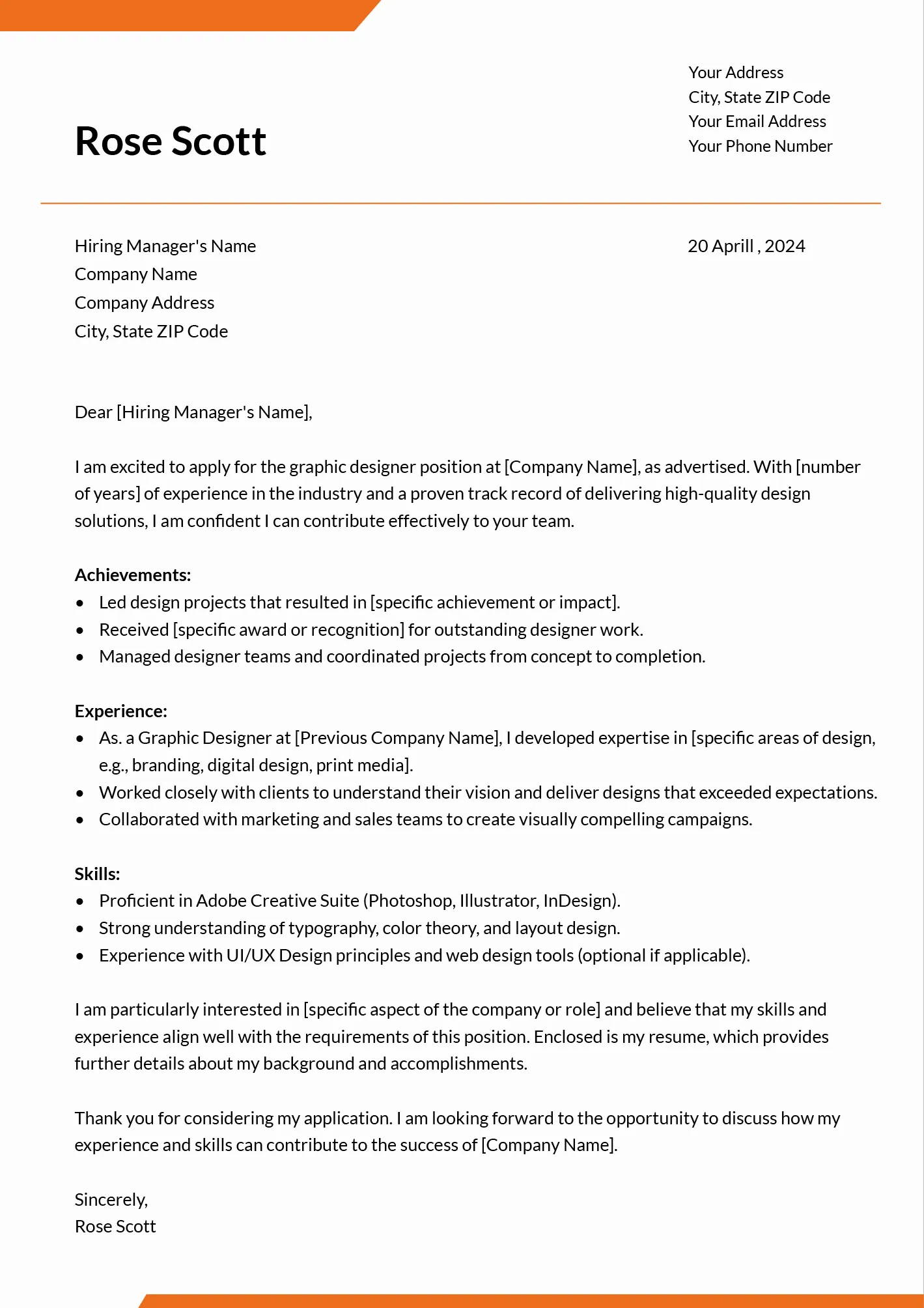
The opening paragraph should grab the reader’s attention. State the position you’re applying for and how you learned about it. Briefly mention your key skills or experience that align with the job requirements. This should be a concise and compelling introduction that gets the hiring manager interested in reading further.
Body Paragraphs
The body of your letter is where you expand on your skills, experience, and accomplishments. Use one or two paragraphs to showcase your relevant qualifications, providing examples of how you’ve succeeded in past projects. Quantify your achievements whenever possible. This section should be tailored to match the job description and highlight how your skills align with the company’s needs.
Closing Paragraph
Reiterate your interest in the position and the company. Summarize your key qualifications and express your enthusiasm for the opportunity. Thank the hiring manager for their time and consideration.
Call to Action
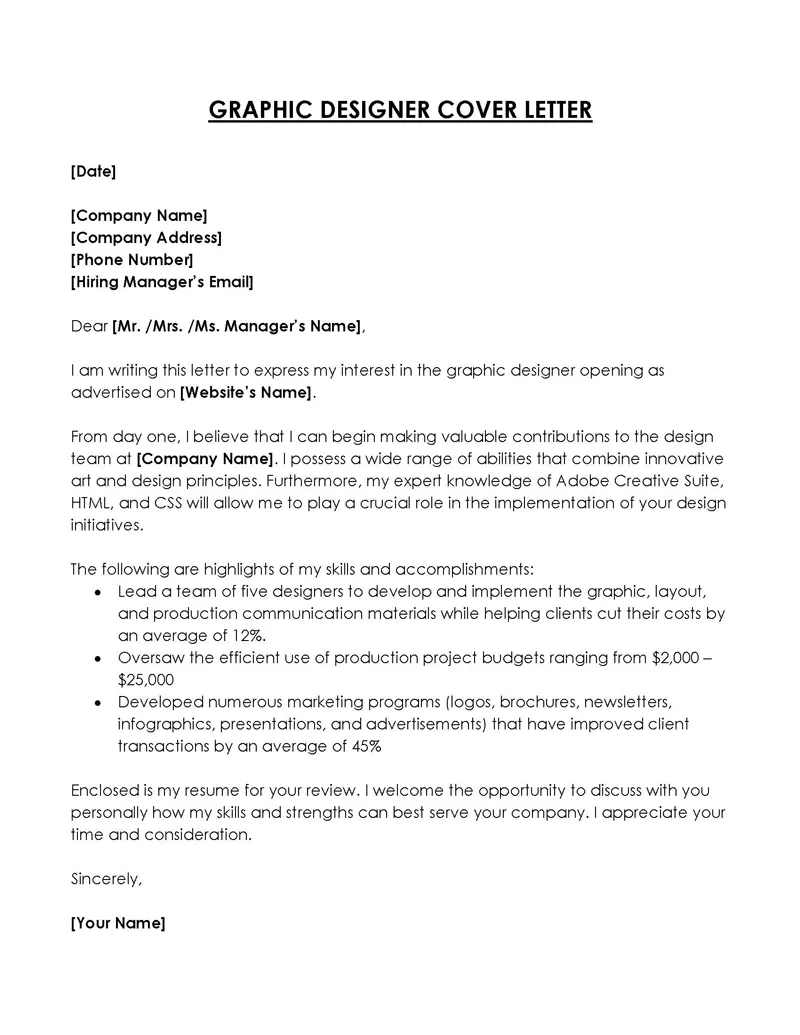
End with a clear call to action. State your availability for an interview and how the hiring manager can contact you. Include your email address and phone number for easy reference. A strong call to action ensures the hiring manager knows what steps to take next.
Cover Letter Examples for Graphic Designers
Cover Letter Example 1
This will vary based on your experience. For example, for a recent graduate or entry level position, emphasize coursework, internships, and personal projects. Highlight any specific software proficiency you’ve gained through your education and any design awards or recognition. Provide details on how you’ve solved real-world design problems during internships or academic assignments.
Cover Letter Example 2
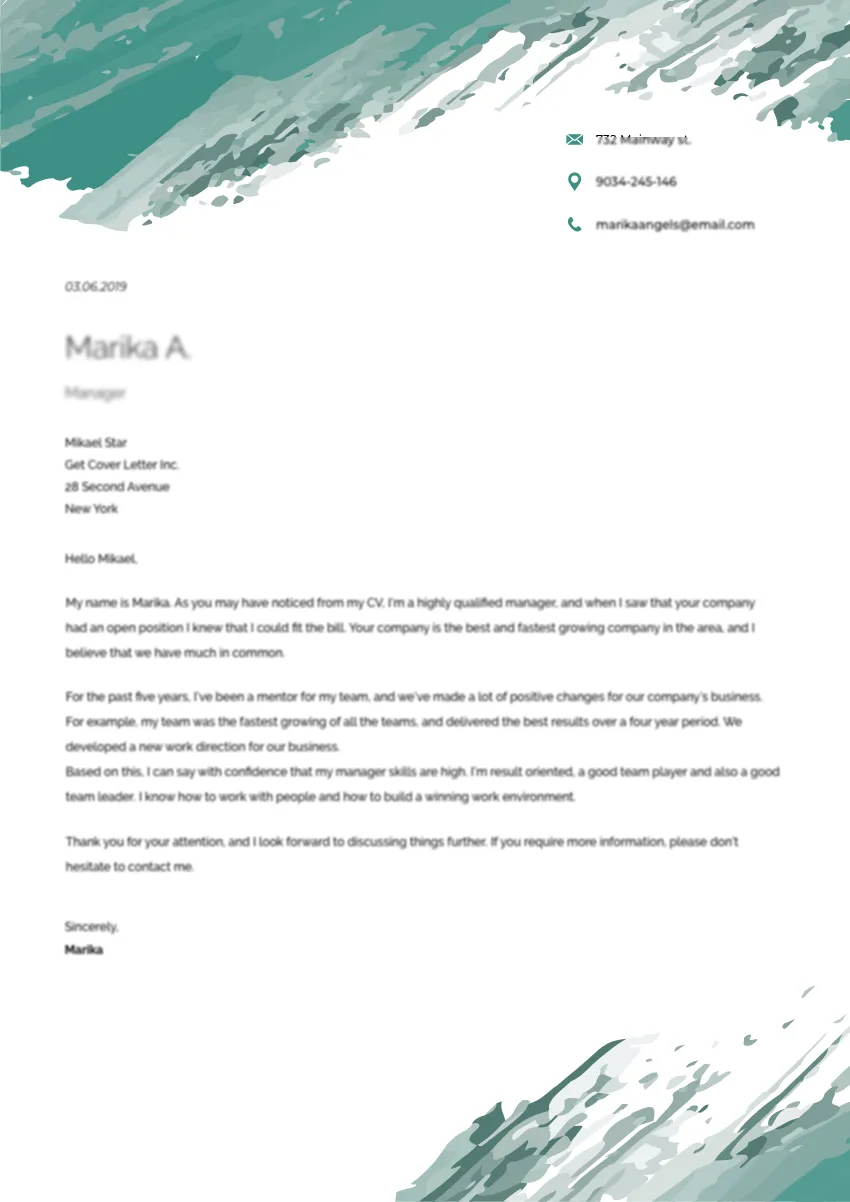
For experienced graphic designers, focus on the results of your work in past roles. Include details of how you increased client conversion rates through design, the campaigns you’ve managed, and your contributions to team projects. Show your ability to handle high-pressure tasks. Mention any awards or recognition you’ve received and describe how you mentored junior designers. Always provide quantifiable results from your past projects to prove your success.
Common Mistakes to Avoid
Generic Cover Letters
Avoid sending generic cover letters. These impersonal letters don’t show your interest in a specific company or role. Always personalize your cover letter to the job, the company, and the hiring manager. Research the company and show that you understand its mission, values, and recent projects. Such attention shows that you are invested in the opportunity and increases your chances of being selected.
Typos and Grammatical Errors
Typos and grammatical errors are a sign of carelessness and can immediately disqualify you. Always proofread your cover letter carefully, using spell check tools and asking another person to review it. These errors can indicate a lack of attention to detail, which is a core competency for any graphic designer. Ensure all your information is correct, and the text flows smoothly. Ensure the information is accurate and easy to read.
Failing to Proofread
Always proofread your cover letter multiple times. Reading it aloud can help you catch any mistakes. Errors can hurt your chances. This is very important.
Not Including a Portfolio Link
A portfolio is your most important tool as a graphic designer, so make sure to provide a link. An easily accessible and well-curated online portfolio is crucial. This lets potential employers view your best work. It provides hiring managers with a quick way to assess your design style. If your online portfolio isn’t up-to-date, consider revamping it before sending your cover letter and resume.
